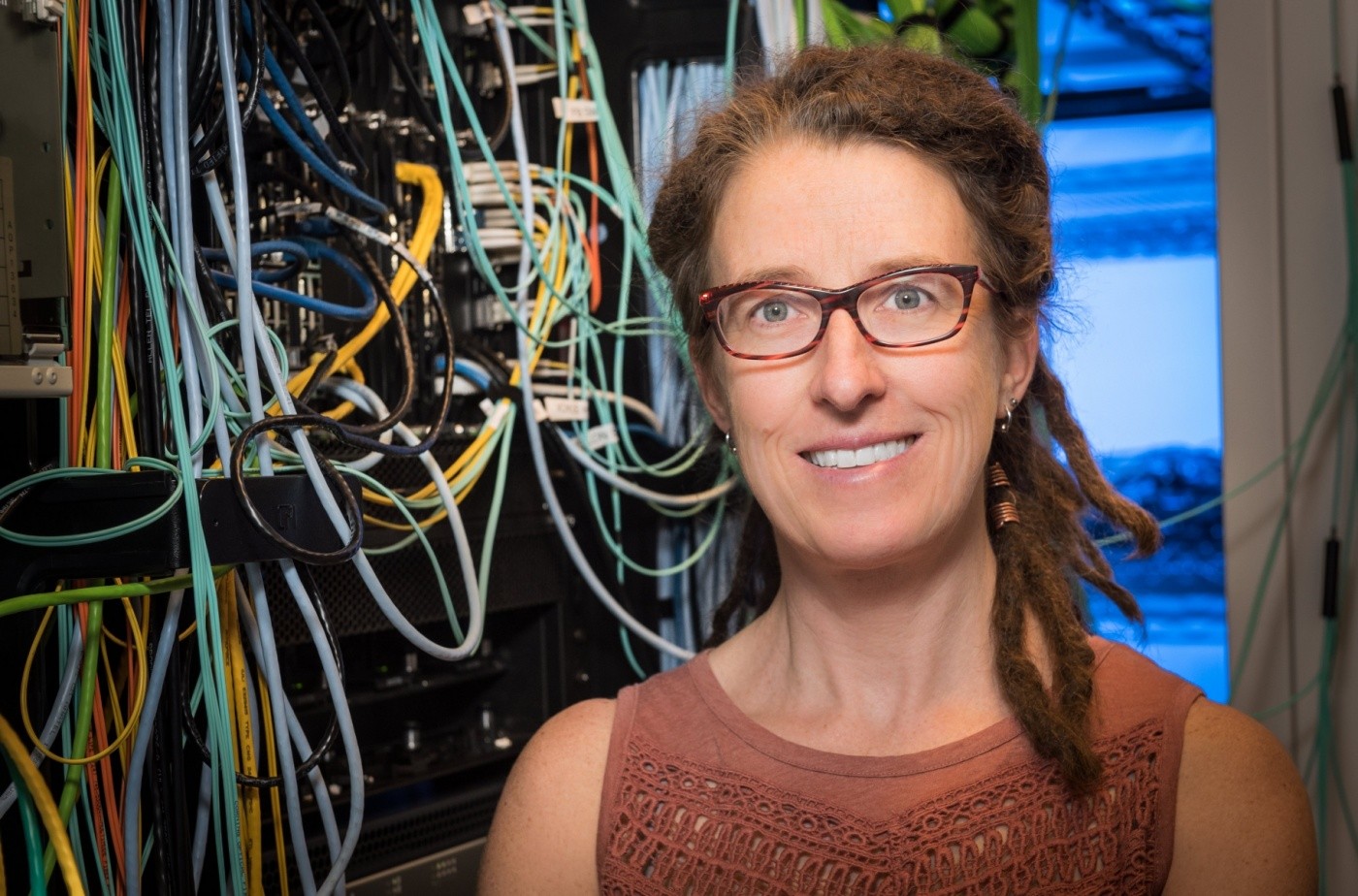Gladstone NOW: The Campaign Join Us on the Journey✕

A team co-led by Katie Pollard examined the fastest changing regions in the human genome to learn how our species evolved.
The most striking genetic differences between humans and chimpanzees are, perhaps unsurprisingly, involved in the development of our brains. Stretches of DNA that make us uniquely human are partly responsible for controlling neuron growth, according to new research from the Gladstone Institutes and UC San Francisco (UCSF). These DNA segments also appear to play a role in psychiatric disorders, such as autism and schizophrenia.
Humans and chimpanzees differ in only 1% of their DNA. Katherine Pollard, PhD, senior investigator at Gladstone, and Nadav Ahituv, PhD, a professor at UCSF, wanted to know how differences within that crucial 1% came to be, and how they make us think and act differently than our closest relative.
Pollard first discovered human accelerated regions (HARs) in 2006. HARs are parts of the genome that remained stable in mammals for millennia, but then quickly changed as humans evolved from our primate ancestors. These stretches of DNA are identical in virtually every human, but differ at several points when we compare ourselves to chimpanzees, Neanderthals, and other mammals.
Pollard subsequently found that the vast majority of HARs—96%—are not genes. Instead, most are gene enhancers, which act like a dimmer switch for a lightbulb, turning gene activity up or down.
In a new study, released on bioRxiv as an online pre-print, Pollard and her colleagues tested the function of over 700 HARs in early-stage human and chimpanzee neurons. They discovered that nearly half served as enhancers for genes that are important in brain development.
“This is a huge leap forward, and it’s been a long time coming,” said Pollard, who is also a professor at UCSF and a Chan Zuckerberg Biohub investigator. “After discovering HARs more than 10 years ago, we had no idea what their function was. We predicted that they might control brain development based on the kinds of genes they are near to and the fact that they are evolutionarily conserved. But we really didn’t have a way to test that hypothesis until now.”
In the past, scientists tried to figure out the function of HARs by testing them one by one. This time, Pollard and Ahituv used an approach inspired by the fields of bioinformatics, stem cell biology, and genomics. They combined innovative stem cell technology with a new screening method that can test thousands of DNA segments at once to see whether or not they are gene enhancers.
Their teams first changed skin cells from both humans and chimpanzees into stem cells. They then coaxed the cells to develop into early-stage neurons. Next, the researchers injected the slightly different human and chimpanzee versions of HARs into both sets of neurons. Finally, they tested the cells to see if a given HAR was active. If it was, it meant that the HAR was an enhancer for a gene involved in neural development.
“The HAR sequences in chimps are pretty much the same as those in mice, rats, dogs, and even chickens; humans are the ones who are different,” said Pollard. “These mutations happened during our evolution, so it wasn’t clear if a human enhancer would function the same in a chimp as it does in human cells.”
The team showed that most of the human and chimpanzee versions of HARs behaved differently. So, the chimpanzee version might turn a gene up a little bit while the human version turned it up a lot. Interestingly, the environment in both cases did not have much of an effect on the function of the HAR, but their sequence did. For example, if a human HAR—one that turned up the human gene a lot—was injected into a chimpanzee brain cell, it would function the same way by turning up the activity of the chimp neuron a lot.
“These enhancers most likely regulate the same genes in human brain development and chimp brain development,” explained Ahituv. “However, the HARs change the amount, timing, or location of the genes being made. For example, if a given gene in a chimpanzee limited how fast cells can divide, the human HAR might turn that gene down, letting the human cells divide faster, which could allow the cortex to expand.”
The team also chose to observe seven HARs in more detail, each of which differs between humans and chimpanzees in several places. The researchers wanted to know why so many changes occurred so close together on the genome, and which changes made the most difference. They discovered that the changes interacted with one another and that each one was necessary.
“We thought that changing a single point within these HARs might account for the difference, but we realized that the various changes within an individual HAR actually work together or interfere with one another,” said first author Hane Ryu, PhD, who was a graduate student in Pollard’s and Ahituv’s laboratories. “It’s a combination of all these changes that leads to the differences in activity.”
Based on their effect on neurons, as well as their locations in the genome, the researchers think that many of the HARs guide genes involved in brain development, as well as psychiatric diseases that are uniquely human, such as autism and schizophrenia.
As for the HARs that weren’t active in brain cells during the study, the scientists think they could influence gene expression at other time points during development, such as when the neuron is fully matured rather than while it’s developing. Alternatively, they could have a function other than enhancing genes, or they could play a role in genes involved in other tissues like heart, bone, or muscle. The next step for Pollard and Ahituv will be to use the same approach to look at HARs in other cell types.
About the Study
The research was funded by the National Institute of Mental Health; the National Heart, Lung, and Blood Institute; the National Human Genome Research Institute; the National Cancer Institute; and the Eunice Kennedy Shriver National Institute of Child Health and Human Development.
Other scientists on the study include Sean Whalen, Alex Williams, Abul Hassan Samee, Kathleen Keough, and Sean Thomas from the Gladstone Institutes. Fumitaka Inoue, Beatriz Alvarado, Arnold Kriegstein, and Alex Pollen from UCSF, and Martin Kircher, Beth Marin, and Jay Shendure from University of Washington also took part in the research.
For Media
Julie Langelier
Associate Director, Communications
415.734.5000
Email
About Gladstone Institutes
Gladstone Institutes is an independent, nonprofit life science research organization that uses visionary science and technology to overcome disease. Established in 1979, it is located in the epicenter of biomedical and technological innovation, in the Mission Bay neighborhood of San Francisco. Gladstone has created a research model that disrupts how science is done, funds big ideas, and attracts the brightest minds.
Support Discovery Science
Your gift to Gladstone will allow our researchers to pursue high-quality science, focus on disease, and train the next generation of scientific thought leaders.
Genomic Maps Untangle the Complex Roots of Disease
Genomic Maps Untangle the Complex Roots of Disease
Findings of the new study in Nature could streamline scientific discovery and accelerate drug development.
News Release Research (Publication) Marson Lab GenomicsSix Gladstone Scientists Named Among World’s Most Highly Cited Researchers
Six Gladstone Scientists Named Among World’s Most Highly Cited Researchers
The featured scientists include global leaders in gene editing, data science, and immunology.
Awards News Release Corces Lab Doudna Lab Marson Lab Pollard Lab Ye LabThe Genome Editing Playbook Is Different in Neurons
The Genome Editing Playbook Is Different in Neurons
The striking findings of a new study could influence how gene therapies are designed for many genetic diseases.
News Release Research (Publication) Neurological Disease Conklin Lab Doudna Lab CRISPR/Gene Editing




